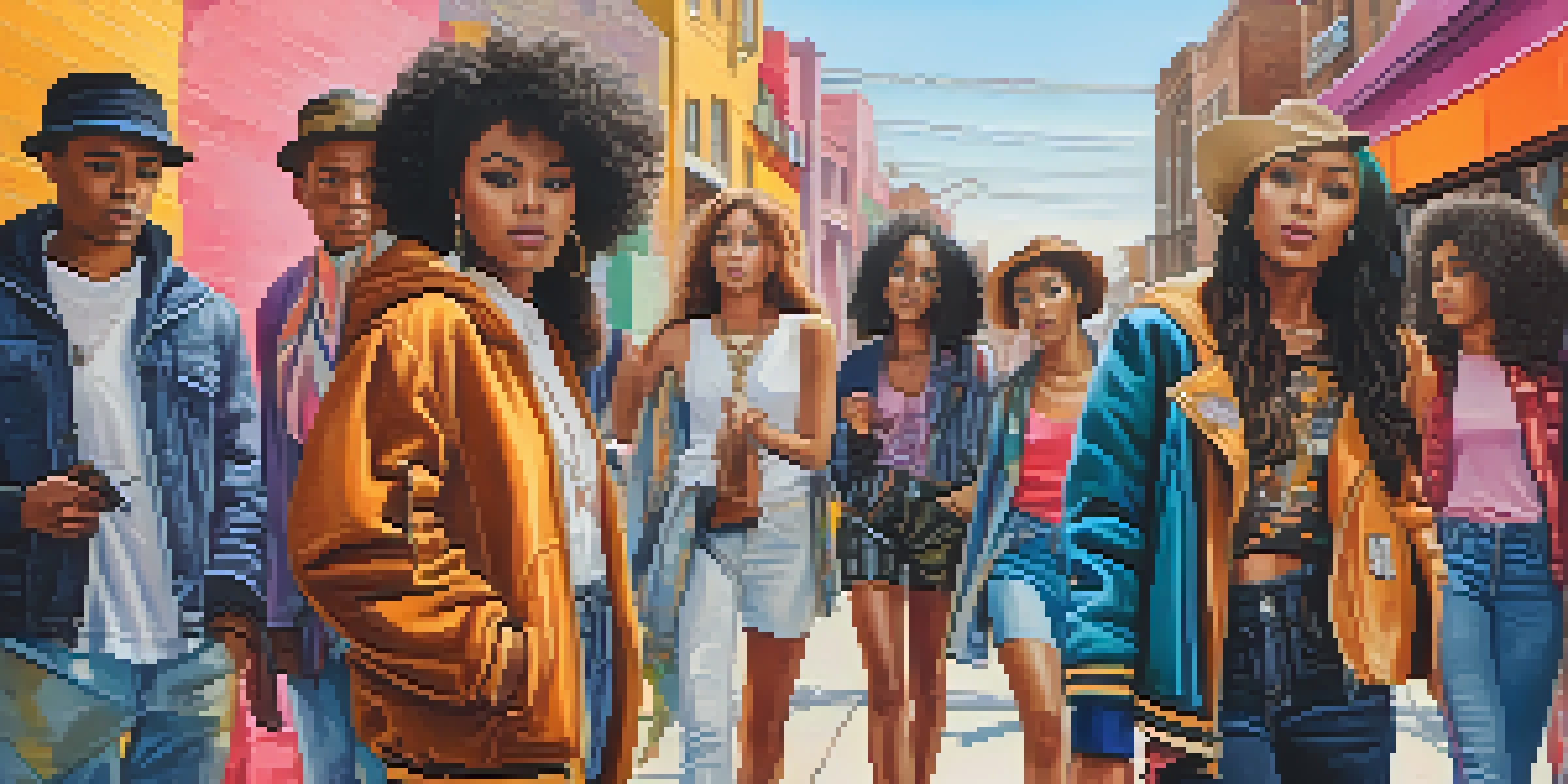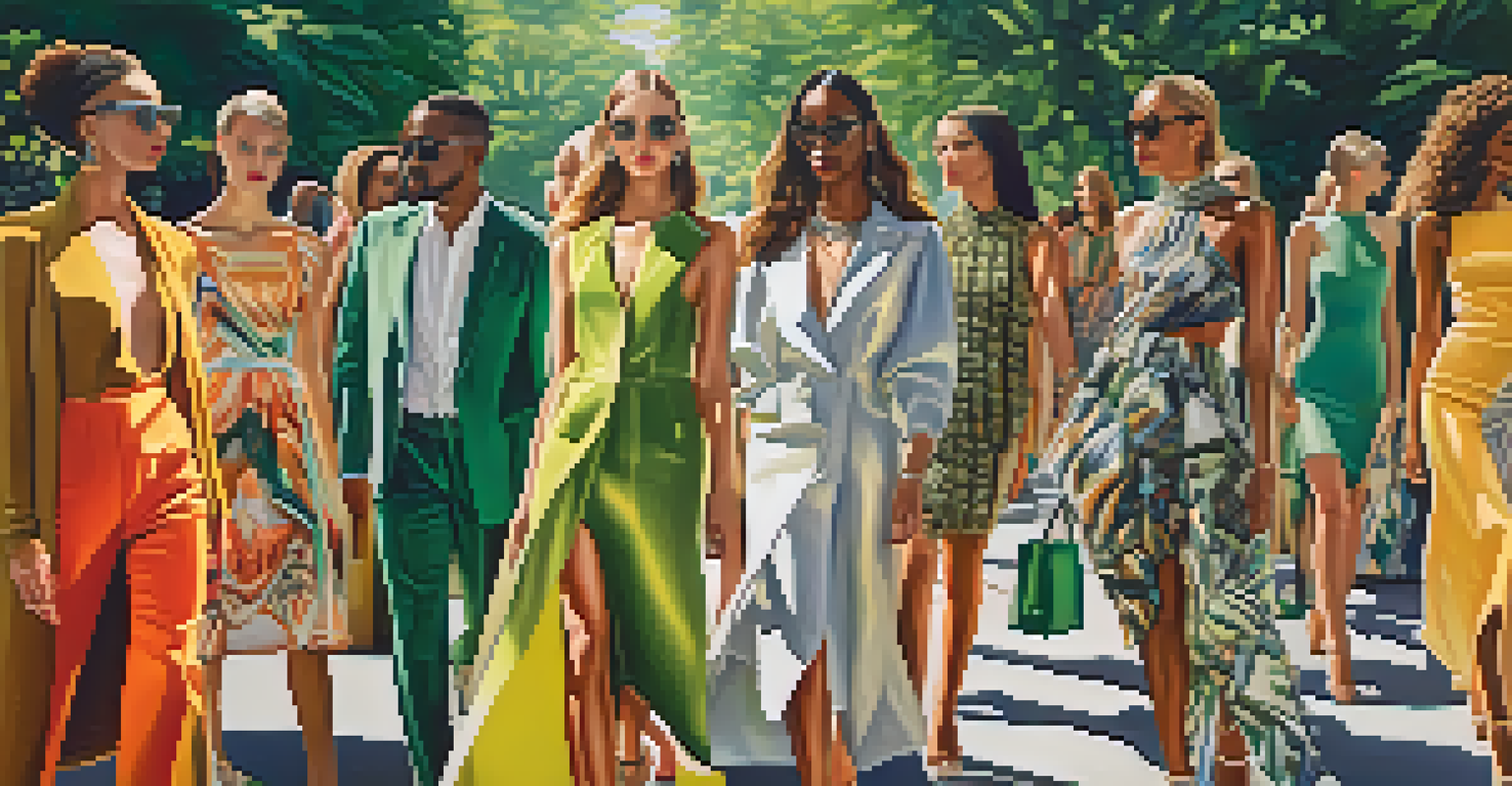Fashion Icons: Shaping Youth Culture Through Trends and Styles

The Power of Fashion Icons in Youth Culture
Fashion icons have a unique ability to shape the attitudes and behaviors of young people. They often embody the ideals of style, confidence, and individuality that many youth aspire to. By showcasing their creativity and self-expression, these figures inspire young people to explore their own fashion identities.
Fashion is the armor to survive the reality of everyday life.
Take, for instance, the influence of icons like Billie Eilish or Harry Styles. Their distinctive styles often challenge traditional gender norms, encouraging youth to embrace diversity in fashion. This push for inclusivity helps young people feel more empowered to express themselves authentically.
Moreover, the impact of social media amplifies the reach of these icons. With platforms like Instagram and TikTok, today's youth can connect directly with their favorite celebrities, making fashion trends more accessible and relatable than ever before.
Historical Fashion Icons and Their Impact
Throughout history, various fashion icons have left indelible marks on youth culture. From the rebellious spirit of James Dean in the 1950s to the glam rock era of David Bowie, each has influenced the youth of their time. These icons not only set trends but also challenged societal norms, encouraging young people to think differently.

For example, the punk movement in the 1970s, led by figures like Vivienne Westwood and Sid Vicious, pushed back against mainstream fashion. This rebellion resonated with youth, igniting a desire for uniqueness and nonconformity that still echoes today.
Fashion Icons Inspire Self-Expression
Icons like Billie Eilish and Harry Styles encourage youth to explore their individuality and embrace diverse styles.
As time has progressed, these historical figures serve as touchstones for modern fashion. Today's youth often look back to these icons for inspiration, blending retro styles with contemporary trends to create their own unique looks.
Modern Icons and Their Influence on Trends
In today's world, modern icons like Rihanna and Zendaya set the tone for current fashion trends. Their ability to blend high fashion with street style makes them relatable to a broad audience. This connection fosters a strong influence over what young people wear and how they express their identities.
Fashion is about dressing according to what’s fashionable. Style is more about being yourself.
Additionally, collaborations between celebrities and brands often result in viral fashion moments. When someone like Kylie Jenner launches a new clothing line, it can lead to a surge of interest and demand among her followers. This phenomenon demonstrates how modern icons can create and manipulate trends almost overnight.
Furthermore, these icons often use their platforms to advocate for social issues, merging fashion with activism. This blend of style and purpose resonates deeply with today's youth, who seek not only to look good but also to make a statement.
Social Media: A Catalyst for Fashion Trends
Social media has transformed the way fashion trends emerge and spread, making it easier for icons to influence youth culture. Platforms like Instagram, Pinterest, and TikTok allow styles to go viral in a matter of hours. Young people are increasingly looking to these spaces for inspiration, often emulating the looks of their favorite influencers.
For instance, TikTok trends like 'cottagecore' or 'dark academia' showcase how quickly styles can shift and evolve. Users often take cues from fashion icons who share their outfits online, leading to an ever-changing landscape of youth fashion. This constant cycle of inspiration keeps things fresh and exciting.
Social Media Amplifies Fashion Trends
Platforms like Instagram and TikTok enable fashion trends to spread rapidly, allowing youth to connect with their favorite icons.
Moreover, social media enables a dialogue between icons and their followers. When celebrities engage directly with fans—through comments or live streams—they create a sense of community that makes young people feel included in the fashion conversation.
The Role of Celebrity Endorsements in Fashion
Celebrity endorsements play a significant role in shaping fashion trends among youth. Brands often collaborate with icons to reach younger audiences, leveraging their influence to drive sales and brand loyalty. This symbiotic relationship benefits both parties, as icons gain access to new styles while brands tap into the star's fanbase.
For example, when a popular artist wears a specific designer during a performance, it can spark a trend that ripples through youth culture. The visibility of that outfit on stage makes it desirable, leading fans to seek out similar styles for themselves.
This dynamic not only affects what young people wear but also how they perceive themselves. When they see their favorite stars wearing certain brands or styles, it can create a sense of aspiration, pushing them to adopt those trends to feel more connected to their idols.
Youth Culture's Response to Fashion Trends
Youth culture is not just a passive recipient of fashion trends; it actively shapes and responds to them. Young people often reinterpret styles in ways that reflect their values and experiences, creating a unique dialogue between fashion and identity. This adaptability ensures that fashion remains relevant and resonates with the younger generation.
For instance, the rise of thrift shopping among Gen Z reflects a shift towards sustainability and individuality. Many young people now prefer vintage finds over fast fashion, showcasing their desire for unique pieces that tell a story. This trend not only highlights their creativity but also their commitment to environmental awareness.
Youth Culture Shapes Fashion Narrative
Young people actively reinterpret fashion trends, reflecting their values and experiences while prioritizing sustainability and individuality.
Additionally, youth culture often reclaims trends from the past, giving them new life and meaning. By mixing vintage styles with contemporary pieces, they establish a fashion narrative that is distinctly their own, demonstrating how dynamic and innovative youth culture can be.
The Future of Fashion Icons and Youth Culture
As we look to the future, the role of fashion icons in shaping youth culture will likely evolve alongside societal changes. With increasing awareness of issues like sustainability and inclusivity, future icons may embody these values more prominently. This shift could lead to a new wave of trends that prioritize ethical consumption and diverse representation.
Moreover, the rise of virtual influencers—digital characters designed to mimic human behavior—could change the landscape of fashion icons altogether. Young people are already engaging with these virtual figures, and their influence may grow as technology advances.

Ultimately, the connection between fashion icons and youth culture is a reflection of changing values. As long as there are individuals willing to challenge norms and inspire others through their style, the impact of fashion on youth will continue to thrive and evolve.